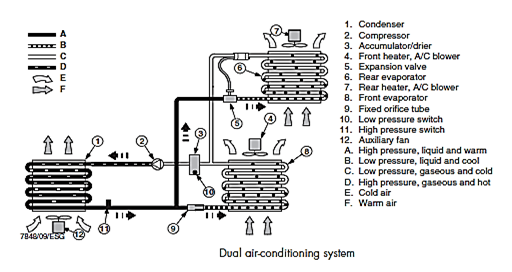←
Automobile Engineering
The Fixed Orifice Valve System (Cycling Clutch Orifice Tube)
Introduction
The air-conditioning system works on a continuous cycle. Temperatures are approximate and are dependent on refrigerant type, system load, and pressure and temperature relationship. The compressor pressurizes the refrigerant from 30 psi to approximately 213 psi depending on system demand. This increases the temperature from approximately 0 to 80°C.
Fixed orifice valve system

- The refrigerant flows into the condenser. The condenser has numerous cooling fins in which the vapour is pumped.
- In the condenser the high pressure vapour condenses into a high pressure liquid.
- This is achieved by reducing the temperature from, for example, 80°C to below 57°C which is the refrigerant’s boiling point.
- This is achieved by forcing air over the surface of the condenser enabling heat to transfer from the refrigerant to the outside air thus reducing its temperature (subcooled).
- Only refrigerant in the form of a high pressure subcooled liquid leaves the bottom of the condenser outlet.
- The liquid refrigerant then passes through a fixed orifice tube – a tube with a fixed cross-sectional area allowing only a metered quantity of liquid refrigerant to pass through it.

- The low pressure, low temperature liquid is then forced to expand rapidly due to the increase in volume of the evaporator.
- This drop in pressure causes the refrigerant to boil (vaporize) and absorb large amounts of heat energy which is transferred from the air flowing over the evaporator’s fins to the evaporator’s surface and thus to the refrigerant through vaporization.
- After the heat is removed from the air it is directed to the vehicle’s interior.
- The low pressure, low temperature liquid/vapour refrigerant flows from the evaporator to the top of the accumulator which acts as a drier and storage device and separates any liquid from vapour to protect the compressor (compressors can only pressurize vapour).
- The large surface area of the accumulator also assists in any final evaporation of liquid refrigerant. The saturated vapour and a tiny percentage of liquid refrigerants to carry oil from the oil bleed leave the accumulator from the top and flow under low pressure to the compressor (suction side) and the cycle repeats itself.
Fig: Dual air-conditioning system